Development of English Learning System by Using NFC Tag
- DOI
- 10.2991/jrnal.k.210713.015How to use a DOI?
- Keywords
- English learning system; educational toy; learning trough play; NFC; IDm
- Abstract
We innovate an educational toy to play the English learning system. The proposed system uses a Raspberry Pi and two Near Field Communication (NFC) readers. The user can learn English words in three steps by using our system. First, NFC tags are presented corresponding to English words and illustrations, such as a cat, dog and chicken etc. Next, a pair of tags is required to select corresponding to an English word and illustration. Finally, by holding the pair over the NFC reader, the answer is displayed on a touch panel to inform whether it is correct or incorrect. Our system has two aspects. The one is an educational system for children and the other is an educational toy playing with children. As to the former, the system helps the children as users can learn English words by intuitive operation such as operating the touch panel and holding the NFC tags. As to the latter, it offers a learning experience with the Information and Communication Technology (ICT). In this paper, we report findings through the construction of the English learning system.
- Copyright
- © 2021 The Authors. Published by Atlantis Press International B.V.
- Open Access
- This is an open access article distributed under the CC BY-NC 4.0 license (http://creativecommons.org/licenses/by-nc/4.0/).
1. INTRODUCTION
Information and communication technology is now a necessary part of our lives. In 2019, 96.1% of households have their own mobile terminals, and 83.4% of households have their own smartphones, and then more than 80% of households are relying on the device [1]. The development and spread of ICT has brought about major changes outside the ICT field. The role of Information and Communication Technology (ICT) in the field of education is also important. In 2020, programming education became compulsory in elementary schools, and the new teaching guidelines for elementary schools announced in March 2017 stated as follows, “In order to cultivate the ability of information utilization, ICT equipment such as computers and networks will be provided at every school. We will equip the appropriate environment to utilize these tools and enhance learning activities [2].” The basic idea of ICT utilization by the Ministry of Education is as follows, “Based on the new teaching guidelines, there are three important aspects. The one is the balanced development of the three pillars of qualities and abilities. The second is the aggressive utilization of ICT as the teaching materials, the teaching and learning tools according to both of the actual conditions of children and schools, and characteristics and learning steps of each subject. The third is the class improvement for the proactive, interactive and deep learning [3].” In addition to ICT utilization such as efficient and effective presentation using the large screen, the goal is to prepare a terminal for each student and promote learning independently and interactively. By using ICT equipments, it is possible to improve the problem on the limited learning time efficiently. Effective utilization of ICT is an important issue for enhancing future educational activities.
The utilization of ICT equipment is underway in all subjects. Especially, the use of ICT in English education is being actively promoted, and 99.1% of schools utilize ICT equipments in English education in elementary schools [4]. However, according to a survey of Japanese children’s use of digital devices in schools at Organisation for Economic Cooperation and Development (OECD) Programme for International Student Assessment (PISA) 2018, the percentage of students who answered that they did not use ICT devices in their school’s “foreign language” class was 67.0%, it is the worst among participating countries [4]. It can be said that the environment in which teachers utilize ICT in English education is in place, but the environment in which students themselves use ICT to learn English is not sufficiently developed.
In this research, we developed an English learning system by using ICT, especially the Near Field Communication (NFC) tag. Our system is a kind of an educational toy and has the advantage that the user enjoy learning English by using NFC tags. The system is basically consists of Raspberry Pi and two NFC readers and cards with NFC tag attached. The user simply selects and places both a card with an animal English name and a card with an animal picture on NFC readers, and then the correct or incorrect answer is shown on the touch panel display. The device gains a new interest of the children and offers ICT experience through simple operations. By using our system, users can learn English through play and get accustomed to involving with ICT. The proposed system consists of easily available electronic devices and can be expected to utilize as a material for programming education at home. In this paper, we report the findings obtained in the construction of the system by using NFC tags. We will show examples of educational toys in Section 2. In Section 3, we will describe our system by using NFC tags. In Section 4, we will show experimental results. In Section 5, we will summarize the paper.
2. EDUCATIONAL TOYS FOR CHILDREN
2.1. Overview of Educational Toys
With the development of ICT in recent years, ICT is also being incorporated into electrical toys of educational use for children. Products so-called educational toys are on the market. Many studies on educational toys using ICT have been active in recent years [5,6]. Currently, interactive speakers equipped with voice user interfaces such as Amazon Echo, Google Home and Clova Friends, and so on are becoming widespread in general households [7]. These studies analyze the interaction between children and interactive speakers with the aim of developing interactive speakers for childcare. Interactive speakers will become more and more popular in general households and the importance for educational toys at home will also become more prominent. Under these circumstances, programming education in elementary schools has started in Japan, and the importance of developing educational toys that use Bluetooth Low Energy (BLE), NFC, QR codes, etc. for the purpose of supporting programming education in general households increase. By using educational toys, users can experience the world of information communication with more intuitive operations than using a smartphone or PC, expanding the range of play from the analog world to the digital world. These toys are more attractive than past toys by connecting multiple devices and exchanging data with wireless communication and have a new aspect in the sense of education to gain children’s potential by learning through play. These toys are very useful as a means to improve their abilities in the development stage as recently emphasized to call programming education.
2.2. CORO-PUTER-Ja.
“CORO-PUTER-Ja.” is a wooden educational toy developed by TDS Co., Ltd. (Tokyo, Japan) [8]. When a wooden hiragana block with an embedded Radio Frequency Identification (RFID) tag is rolled onto a wooden frame with an embedded reader, the reader reads the tag and then the hiragana is displayed on a smartphone connected via Bluetooth. This allows the user to learn letters and words and get in touch with technology through the play of rolling blocks. Even infants can easily pick up blocks, carry them to the frame, and roll them, so they can learn through play. It can be said that the strength of educational toys is that a lot of information can be obtained with this simple operation.
3. ENGLISH LEARNING SYSTEM USING NFC
3.1. Features of our English Learning System
In this research, we innovated an educational toy to play the English learning system by using NFC tags for children that aims to integrate English learning and ICT. By using this system, the user can learn English through play and can also experience some of the ICT. NFC is rooted in radio-frequency identification technology known as RFID and it offers a contactless exchange of data over short distances. Two NFC-capable devices are connected via a point-to-point contact over a distance of 0–2 cm. This connection can be used to exchange data between the devices.
3.2. Development Environment
In this system, the user proceed the English learning simply by holding a card with an animal English name and a card with an animal picture over the NFC reader. The system consists of Raspberry Pi 4, and the OS Raspbian (version 10 (buster)) as the Platform, two NFC readers and illustration cards with an English animal name and or animal picture, at which the NFC tag is attached. Python (version 3.7.3) is used to construct the system. NFC Py (version 1.0.3) is used to operate the NFC reader.
3.3. System Overview
We will explain the outline of our system. Figure 1 shows the system configuration diagram.
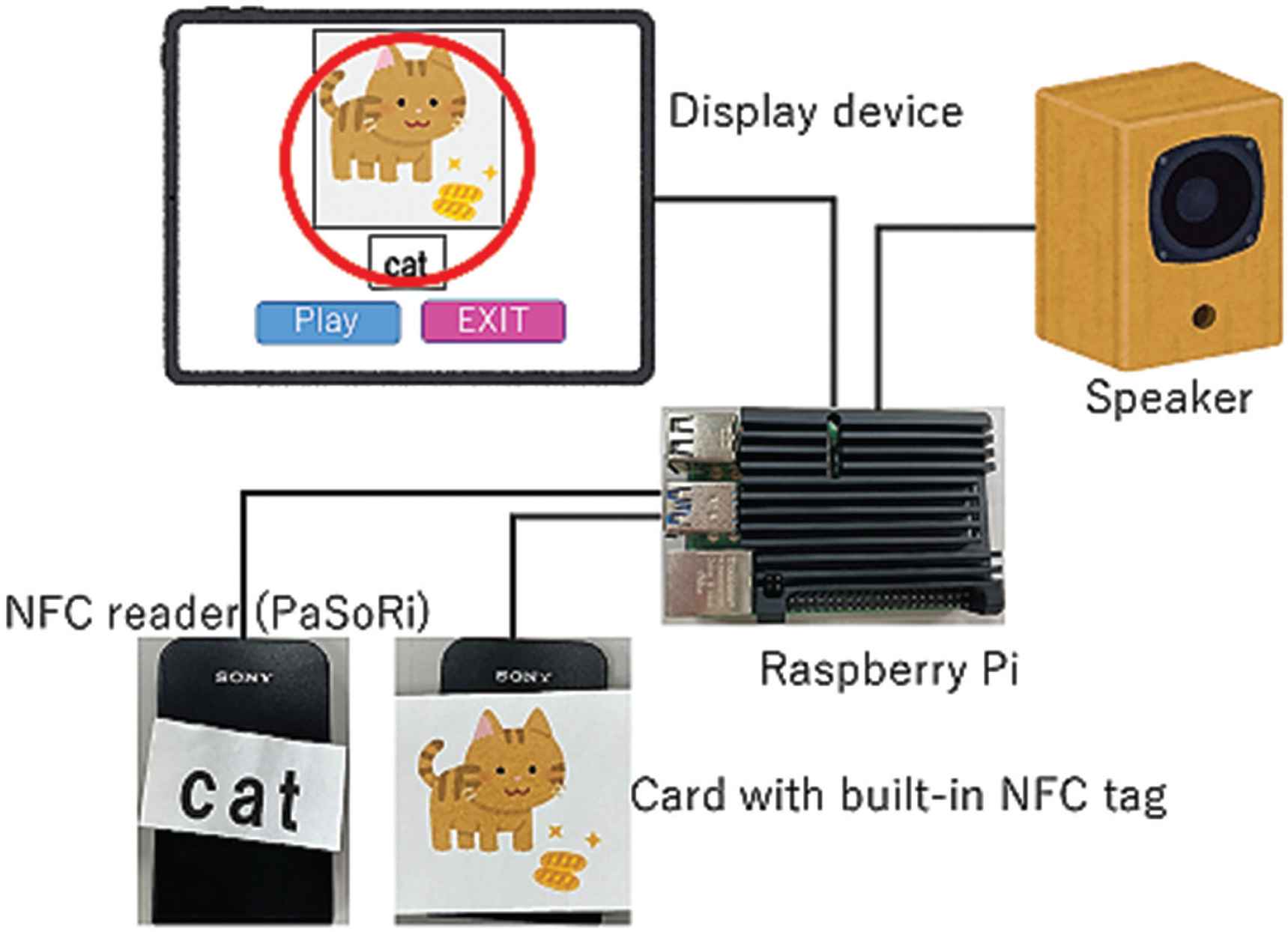
System configuration diagram.
This tool processes the content reading by the NFC reader with Raspberry Pi and reflects it on the touch panel. Sony’s PaSoRi RC-S380/S is used to read NFC tags, Kuman’s 7-inch touch panel is used to display the screen, JBL Charge 4 portable Bluetooth speaker is used to play audio, and Raspberry Pi 4 is used to process and execute codes. The purpose of this system is to learn the English names of animals. There are two kinds of cards, “Animal Name Card” with an animal English name and “Animal Card” with an animal picture as shown in Figure 2.
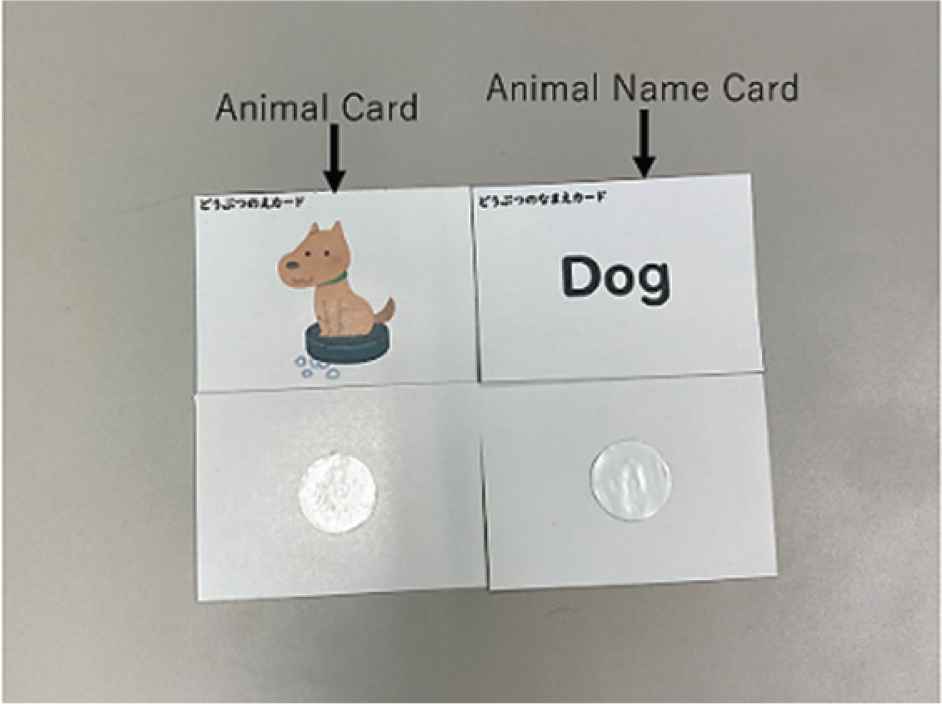
Card with NFC tag attached.
The NFC tag is embedded on the back of each card. In this system, unique serial number IDm of each NFC tag is associated with each of the “Animal Name Card” and “Animal Card”, and the correct or incorrect answer is determined by pairing two IDm. The NFC tag used for each card is Sanwa Supply’s NFC tag (product model number: MM-NFCT). Two NFC readers are prepared so that the “Animal Name Card” and “Animal Card” can be read at the same time.
A scene of playing by using our English learning system is shown in Figure 3. After trial and error, the operation panel is designed as shown in Figure 3. The touch panel display is placed at the top and two NFC readers is placed at the bottom. The operation panel is designed so that the user can simply know where to put the “Animal Name Card” and “Animal Card”. The user places the “Animal Name Card” and “Animal Card” on each reader (dashed frames in Figure 3) and presses the “Play” button on the touch panel, and then the correct or incorrect answer is shown on the touch panel display as shown in Figure 3.
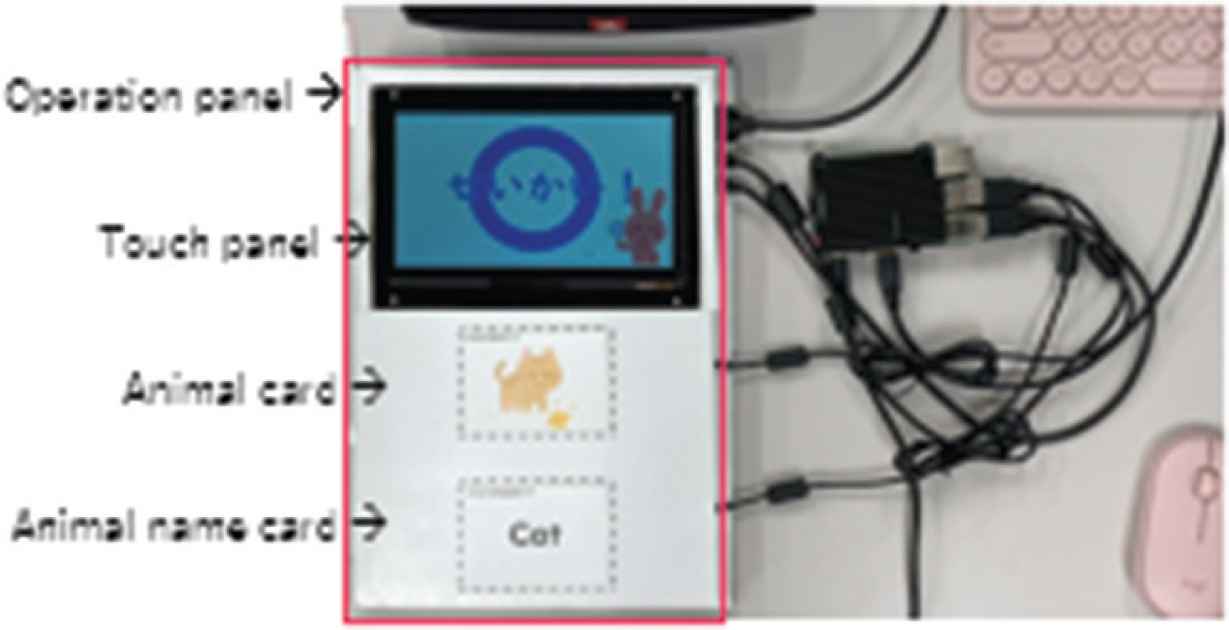
A scene of playing by using our system.
3.4. System Behavior
The system behavior through play is shown in Figures 4–6. As to Figure 4, the user places the “Animal Name Card” on the lower dashed frame and “Animal Card” on the upper dashed frame on the operation panel and presses the “Play” button, and then the IDm of each NFC tag is read by the reader and whether the pair of the card is correct or incorrect is shown on the touch panel display. A correct case is shown in Figure 5 and an incorrect case is shown in Figure 6. In case that the answer is correct, for example, the dog’s “Animal Name Card” and the dog’s “Animal Card” in Figure 5, a notification sound indicating that the pair is correct is set to ring and an illustration (Ο) is displayed on the touch panel. In case that the answer is incorrect, for example, a cat’s “Animal Card” and a dog’s “Animal Name Card” in Figure 6, a sound indicating that the pair is incorrect is set to ring and an illustration (×) is displayed on the touch panel. In addition, only if the pair is incorrect, the correct animal bark that matches the “Animal Card” is played through the speaker, and the frame of the “Animal Name Card” on the screen is blinked to suggest that another “Animal Name Card” is to be placed. The reason for playing the correct animal bark that matches the “Animal Name Card” is to make it easier to imagine an animal illustration by hearing of the bark.
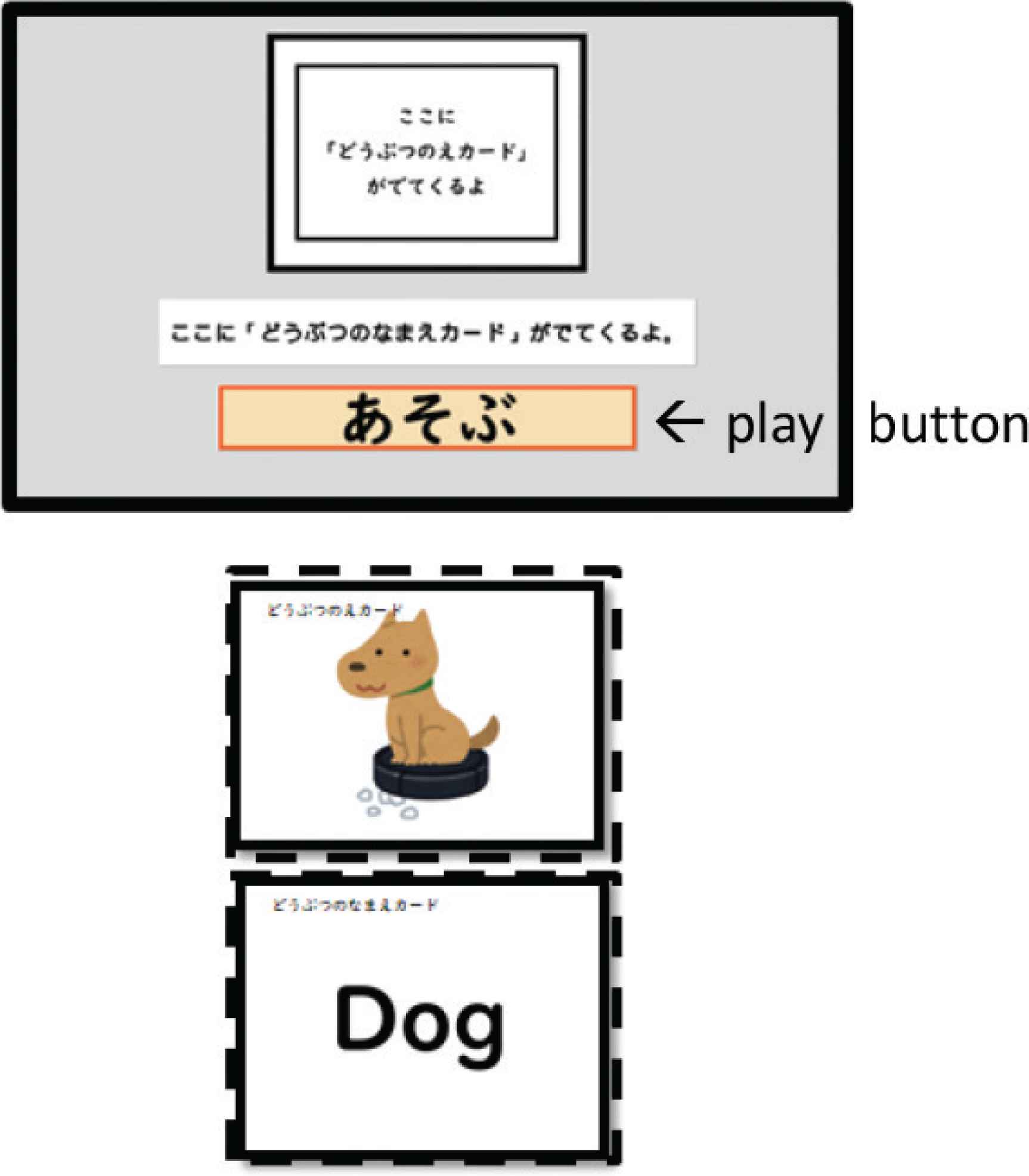
Panel display playing with the proposed system.
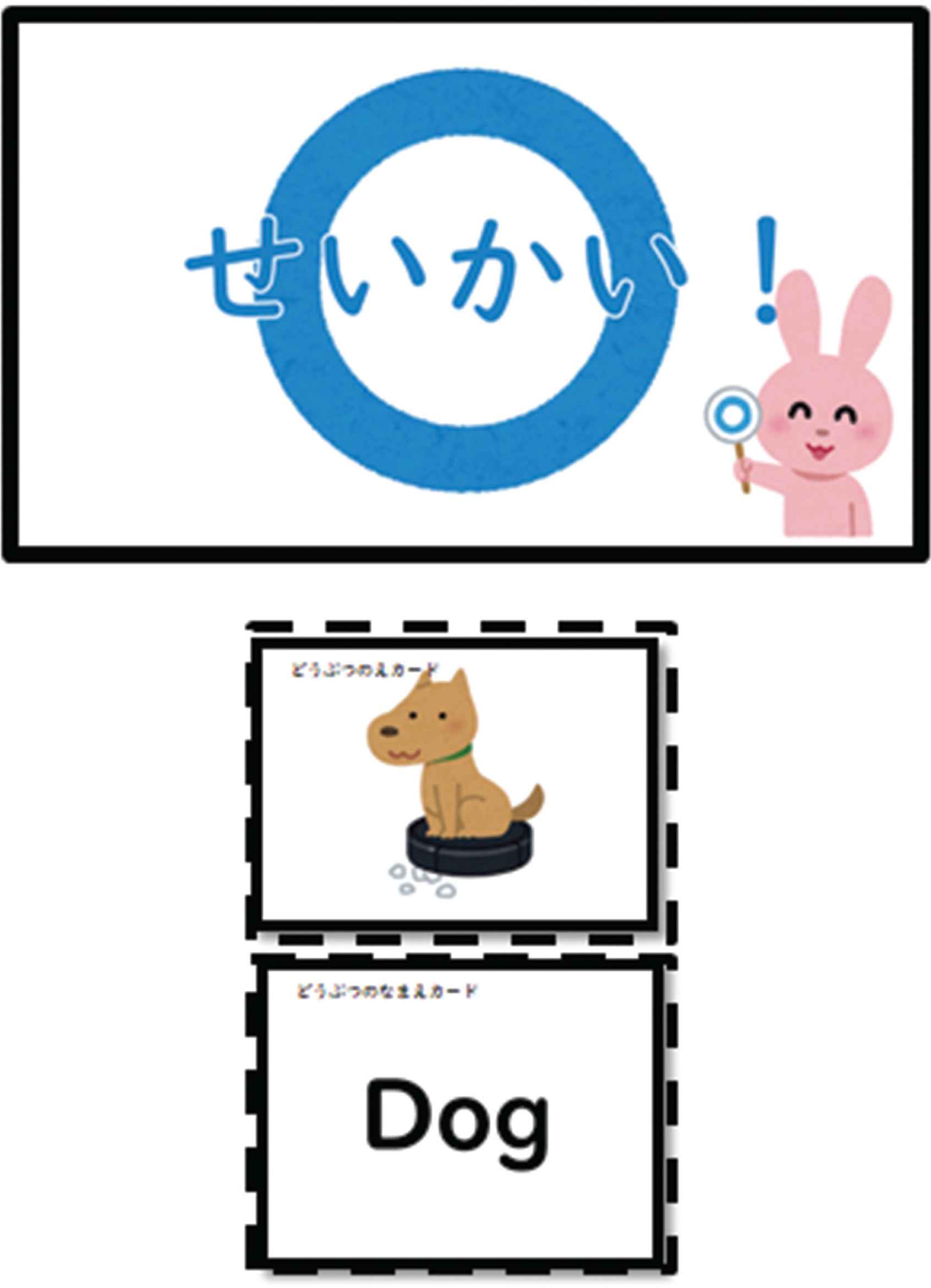
Panel display for a correct pair of cards.
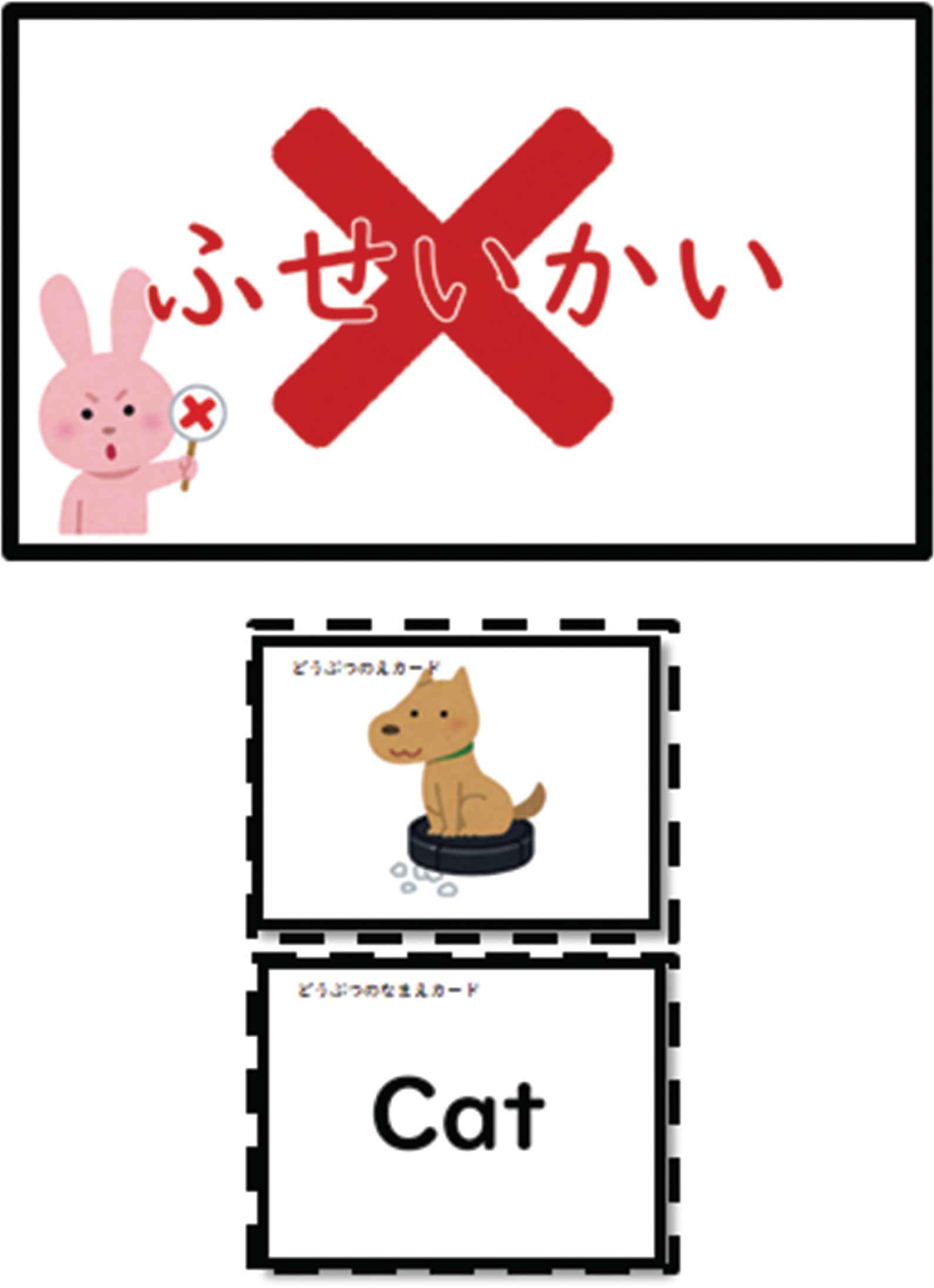
Panel display for an incorrect pair of cards.
4. EXPERIMENTAL RESULTS
4.1. Questionnaire as to System Usability
In this research, we have a plan of a two-stage experimental process. The first is for the verification of the system usability on our panel design and the second is for the verification of the learning effect by using the proposed system. First, we describe the experimental result of the first stage, since it is not possible to conduct experiments on elementary school under the current conditions of the coronavirus disease. For the first stage, we conducted a questionnaire to 42 students of our university, who have the expertise in system usability. The questionnaire is focused on whether the system is enjoyable as an educational toy and easy to use in terms of panel design.
4.2. Experimental Results
We presented the following questions and choices of answer:
---
Question 1: Do you enjoy using the system?
Answer: A is ‘boring’, B is ‘somewhat boring’, C is ‘somewhat fun’, and D is ‘fun’.
---
Question 2: Is it easy to use the system?
Answer: A is ‘difficult to use’, B is ‘somewhat difficult to use’, C is ‘somewhat easy to use’, and D is ‘easy to use’.
---
At this experiment, after giving a short lecture on the system usability, we conduct the questionnaire. The examinees answer the questionnaire after using the proposed English learning system. The results of the questionnaire are shown in Tables 1 and 2, respectively.
| Answer | A | B | C | D |
|---|---|---|---|---|
| Counts | 0 | 0 | 11 | 31 |
Q.1: Do you enjoy using the system?
| Answer | A | B | C | D |
|---|---|---|---|---|
| Counts | 0 | 1 | 16 | 25 |
Q.2: Is it easy to use the system?
In each question, answers A–D were weighted as 1–4 respectively. Finally, the weighted average for each question was calculated. As shown in the results, the average on Question 1 was 3.74, which implies that it was fun to use the system for users. The average on Question 2 was 3.57, which implies that it is sufficiently easy to use the system. According to the free description part in the questionnaire, the system design needs to be refined furthermore. Colors and shapes of cards and the placement method can be improved to help user can use the NFC reader easier and recognize the contents.
5. CONCLUSION
In this research, we prototyped an English learning system that integrates English learning and ICT by using NFC tags. In the proposed concept as reading NFC tags with two NFC readers, our system can effectively manage English words and illustrations to represent those word meaning in a complementary way. In the future, experiment for the verification of the learning effect by using the proposed system. The system will be improved to enhance the mechanism for children to learn with a high interest.
CONFLICTS OF INTEREST
The authors declare they have no conflicts of interest.
ACKNOWLEDGMENT
This work was supported by Nagasaki West Rotary Club.
AUTHORS INTRODUCTION
Mr. Shogo Aizawa
 He received his Bachelor’s degree of Science in Information Systems at University of Nagasaki. His interest is vitalization of regional community through educational workshop by using multimedia contents with IoT and AI.
He received his Bachelor’s degree of Science in Information Systems at University of Nagasaki. His interest is vitalization of regional community through educational workshop by using multimedia contents with IoT and AI.
Dr. Motohide Yoshimura
 He is a Professor of Faculty of Information Systems at University of Nagasaki in Japan. He received his Dr. of Eng. degree in Graduate School of Engineering at Tokushima University in 1999. His research interests is town planning and product design by using IoT, AI, and so on.
He is a Professor of Faculty of Information Systems at University of Nagasaki in Japan. He received his Dr. of Eng. degree in Graduate School of Engineering at Tokushima University in 1999. His research interests is town planning and product design by using IoT, AI, and so on.
REFERENCES
Cite this article
TY - JOUR AU - Shogo Aizawa AU - Motohide Yoshimura PY - 2021 DA - 2021/07/23 TI - Development of English Learning System by Using NFC Tag JO - Journal of Robotics, Networking and Artificial Life SP - 145 EP - 149 VL - 8 IS - 2 SN - 2352-6386 UR - https://doi.org/10.2991/jrnal.k.210713.015 DO - 10.2991/jrnal.k.210713.015 ID - Aizawa2021 ER -
